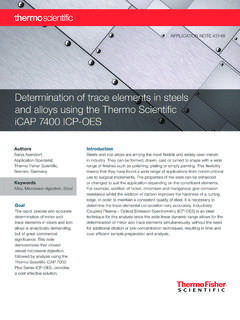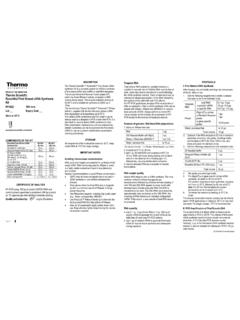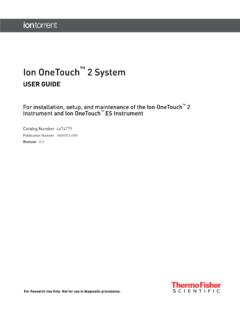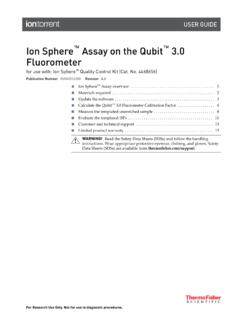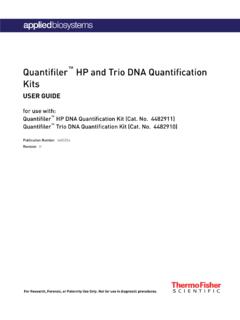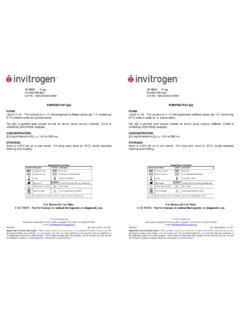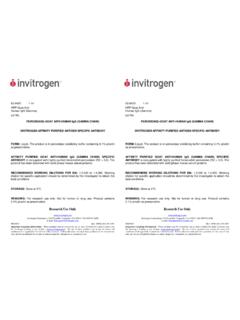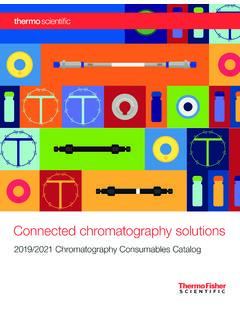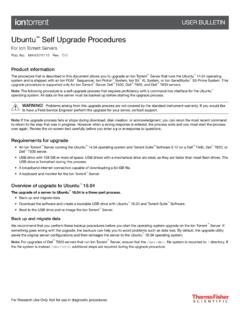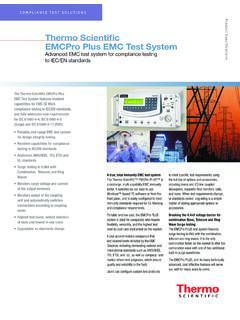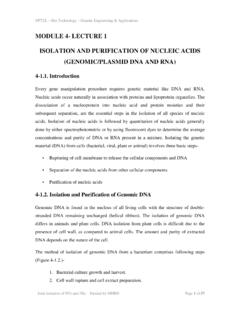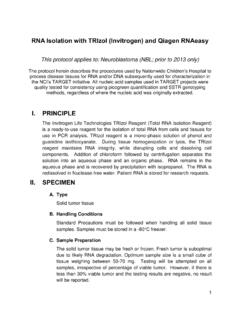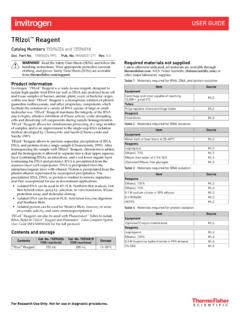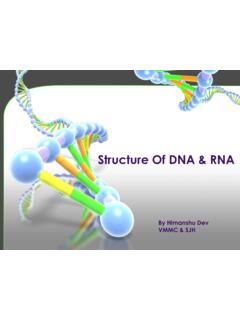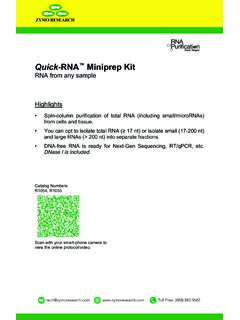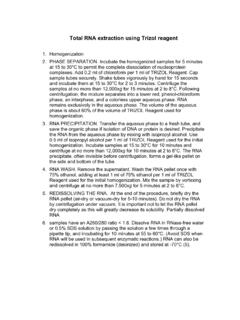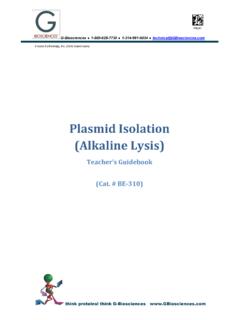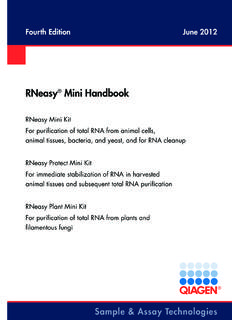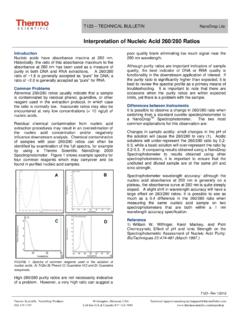Transcription of TRIzol Reagent (DNA isolation) User Guide - Pub. no ...
1 TRIzol ReagentExperimental protocol for DNA isolationCatalog Numbers 15596026 and 15596018 Pub. No. MAN0016385 Rev. ! Read the Safety Data Sheets (SDSs) and follow thehandling instructions. Wear appropriate protective eyewear,clothing, and gloves. Safety Data Sheets (SDSs) are availablefrom informationInvitrogen TRIzol Reagent is a ready-to-use Reagent , designed toisolate high quality total RNA (as well as DNA and proteins) from celland tissue samples of human, animal, plant, yeast, or bacterial origin,within one hour. TRIzol Reagent is a monophasic solution of phenol,guanidine isothiocyanate, and other proprietary components whichfacilitate the isolation of a variety of RNA species of large or smallmolecular size. TRIzol Reagent maintains the integrity of the RNAdue to highly effective inhibition of RNase activity while disruptingcells and dissolving cell components during sample Reagent allows for simultaneous processing of a large numberof samples, and is an improvement to the single-step RNA isolationmethod developed by Chomcynski and Sacchi (Chomczynski andSacchi, 1987).
2 TRIzol Reagent allows to perform sequential precipitation of RNA,DNA, and proteins from a single sample (Chomczynski, 1993). Afterhomogenizing the sample with TRIzol Reagent , chloroform is added,and the homogenate is allowed to separate into a clear upper aqueouslayer (containing RNA), an interphase, and a red lower organic layer(containing the DNA and proteins). RNA is precipitated from theaqueous layer with isopropanol. DNA is precipitated from theinterphase/organic layer with ethanol. Protein is precipitated from thephenol-ethanol supernatant by isopropanol precipitation. Theprecipitated RNA, DNA, or protein is washed to remove impurities,and then resuspended for use in downstream applications. Isolated RNA can be used in RT-PCR, Northern Blot analysis, DotBlot hybridization, poly(A)+ selection, in vitro translation, RNaseprotection assay, and molecular cloning.
3 Isolated DNA can be used in PCR, Restriction Enzyme digestion,and Southern Blots. Isolated protein can be used for Western Blots, recovery of someenzymatic activity, and some RNA and protein isolation , refer to TRIzol Reagent User Guide (Pub. No. MAN0001271). TRIzol Reagent can also be used with Phasemaker Tubes to isolateRNA. Refer to TRIzol Reagent and Phasemaker Tubes Complete SystemUser Guide (Pub. No. MAN0016163) for the full and storageContentsCat. No. 15596026(100 reactions)Cat. No. 15596018(200 reactions)StorageTRIzol Reagent100 mL200 mL15 30 CRequired materials not suppliedUnless otherwise indicated, all materials are available through MLS: Fisher Scientific ( ) orother major laboratory 1 Materials required for all isolationsItemSourceEquipmentCentrifuge and rotor capable of reaching12,000 g and 4 CMLST ubesPolypropylene microcentrifuge tubesMLSR eagentsChloroformMLST able 2 Materials required for DNA isolationItemSourceReagentsEthanol, 100%MLSE thanol, 75% M sodium citrate in 10% ethanolMLS8 mM NaOHMLSHEPESMLSI nput sample requirementsIMPORTANT!
4 Perform dna isolation immediately after samplecollection or quick-freeze samples immediately after collection andstore at 80 C or in liquid nitrogen until DNA typeStarting material per 1 mL ofTRIzol ReagentTissues[1]50 100 mg of tissueCells grown in monolayer1 105 1 107 cells grown inmonolayer in a cm culture dish(10 cm2)Cells grown in suspension5 10 106 cells from animal, plant,or yeasty origin or 1 107 cells ofbacterial origin[1]Fresh tissues or tissues stored in RNAlater Stabilization Solution (Cat. No. AM7020). Procedural guidelines Perform all steps at room temperature (20 25 C) unless otherwisenoted. Use cold TRIzol Reagent if the starting material contains highlevels of RNase, such as spleen or pancreas samples.
5 Use disposable, individually wrapped, sterile plastic ware andsterile, disposable RNase-free pipettes, pipette tips, and tubes. Wear disposable gloves while handling reagents and RNAsamples to prevent RNase contamination from the surface of theskin; change gloves frequently, particularly as the protocolprogresses from crude extracts to more purified GUIDEFor Research Use Only. Not for use in diagnostic procedures. Always use proper microbiological aseptic techniques whenworking with RNA. Use RNaseZap RNase Decontamination Solution ( AM9780) to remove RNase contamination from work surfacesand non-disposable items such as centrifuges and pipettes usedduring samples and separate and homogenize samples in TRIzol Reagent according toyour starting material.
6 Tissues:Add 1 mL of TRIzol Reagent per 50 100 mg of tissue to thesample and homogenize using a homogenizer. Cell grown in monolayer:a. Remove growth Add mL of TRIzol Reagent per 1 105 107 cellsdirectly to the culture dish to lyse the Pipet the lysate up and down several times to homogenize. Cells grown in suspension:a. Pellet the cells by centrifugation and discard Add mL of TRIzol Reagent per mL of sample (5 10 106 cells from animal, plant, or yeasty origin or 1 107cells of bacterial origin) to the : Do not wash cells before addition of TRIzol Reagentto avoid mRNA Pipet the lysate up and down several times to : The sample volume should not exceed 10% of the volumeof TRIzol Reagent used for POINT Samples can be stored at 4 C overnight or at 20 C for up to a (Optional)
7 If samples have a high fat content, centrifuge the lysatefor 5 minutes at 12,000 g at 4 10 C, then transfer the clearsupernatant to a new for 5 minutes to permit complete dissociation of thenucleoproteins mL of chloroform per 1 mL of TRIzol Reagent used forlysis, then securely cap the for 2 3 the sample for 15 minutes at 12,000 g at 4 mixture separates into a lower red phenol-chloroform, andinterphase, and a colorless upper aqueous the aqueous phase containing the RNA, then proceeddirectly to the next section with the interphase containing DNAI solate DNA from the interphase and the lower phenol-chloroform phase saved from Lyse samples and separate phases on page any remaining aqueous phase overlying the is critical for the quality of the isolated mL of 100% ethanol per 1 mL of TRIzol Reagent used for the tube, mix by inverting the tube several for 2 3 for 5 minutes at 2000 g at 4 C to pellet the the phenol-ethanol supernatant to a new supernatant is used for protein isolation [refer to TRIzol Reagent User Guide (Pub.)]
8 No. MAN0001271)], if needed, and can be stored at 70 C for several the the pellet in 1 mL of M sodium citrate in 10% ethanol, pH , per 1 mL of TRIzol Reagent used for for 30 minutes, mixing occasionally by gentle : The DNA can be stored in sodium citrate/ethanol for at least 2 for 5 minutes at 2000 g at 4 the supernatant with a step 2a step 2d : Repeat step 2a step 2d twice for large DNA pellets (>200 g). the pellet in 2 mL of 75% ethanol per 1 mL of TRIzol Reagent used for for 10 20 minutes, mixing occasionally by gentle : The DNA can be stored in 75% ethanol at several months at 4 for 5 minutes at 2000 g at 4 the supernatant with a or air dry the DNA pellet for 5 10 ! Do not dry the pellet by vacuum the the pellet in mL of 8 mM NaOH by pipetting up and : We recommend resuspending the DNA is a mild base because isolated DNA does not resuspendwell in water or Tris for 10 minutes at 12,000 g at 4 C to remove insoluble the supernatant to a new tube, then adjust pH as needed with to downstream applications, or store the DNA at 4 C overnight.
9 For longer-term storage at 20 C,adjust the pH to 7 8 with HEPES and add 1 mM the DNA2 TRIzol Reagent ( dna isolation ) User GuideDetermine the DNA yield using one of the following at 260 nm provides totalnucleic acid content, while absorbance at280 nm determines sample purity. Sincefree nucleotides, RNA, ssDNA, and dsDNSabsorb at 260 nm, they all contribute tothe total absorbance of the Dilute sample in water or buffer (pH > ), then measureabsorbance at 260 nm and 280 the DNA concentration using the formula A260 dilution 50 = g Calculate the A260/A280 ratio of ~ is considered samples can be quantified by absorbance without prior dilutionusing the NanoDrop Spectophotometer. Refer to the instrument'sinstructions for more selectively measures intactDNA, but does not measure protein orother contaminant present in the sample Quantify dsDNA yield using the appropriate Qubit or Quant-iT dsDNA Assay Kit (Cat.)
10 Nos. Q32850, Q32851, Q33120, or Q33130).Refer to the kit's instructions for more 3 Typical DNA (A260/280 of ) yields from various starting materialsStarting materialQuantityDNA yieldFibroblasts1 106 cells5 7 gCultured cells, mammal1 106 cells5 7 gSkeletal muscles and brain1 mg2 3 gPlacenta1 mg2 3 gLiver1 mg3 4 gKidney1 mg3 4 g4 Determine the DNA yieldTroubleshootingObservationPossible causeRecommended actionA lower yield than expected isobservedThe samples were incompletelyhomogenized or the amount of starting tissue samples into smaller pieces and ensure the tissue iscompletely immersed in TRIzol Reagent to achieve total pellet was incompletelysolubilizedIncrease the solubilization rate by pipetting the sample repeatedly.
